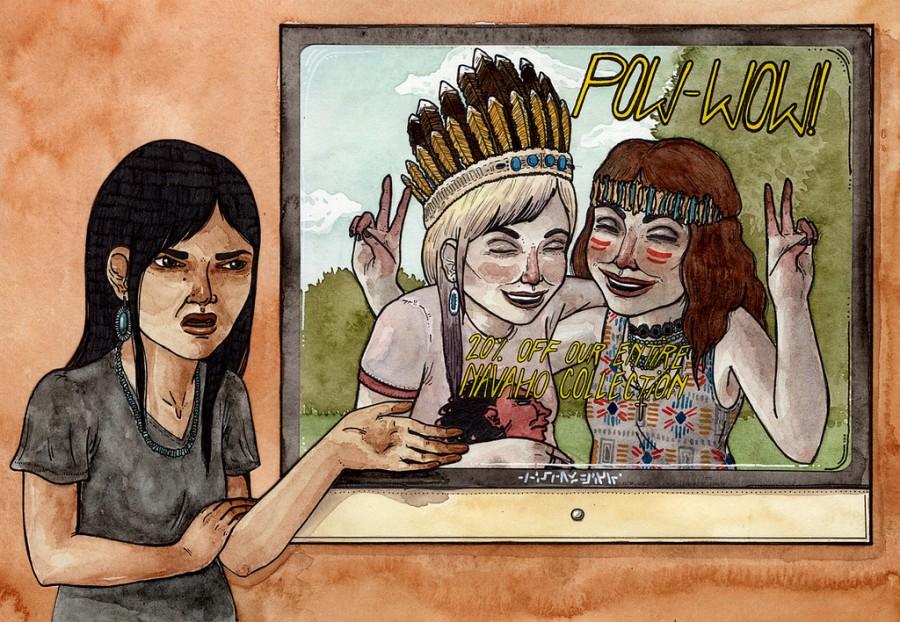It’s a Culture, Not a Costume
A comic depicting white, privileged people donning Native American cultural attire as casual wear. This is an example of when cultural appropriation is wrong, because it demonstrates an entire cultural group being watered down to a fashion aesthetic/insignificant costume.
Bindis categorized as “Halloween items.” Blackface. Hijabs donned by non-Muslims for fun. False Native American war bonnets sported at costume parties. All of these are distasteful examples of cultural appropriation.
Cultural appropriation is defined as “taking intellectual property, traditional knowledge, cultural expressions, or artifacts from someone else’s culture without permission.” It may encompass adopting sacred relics as casual accessories, dressing up as an ethnic stereotype, or somehow trivializing cultural elements by neglecting to take the time to learn and appreciate the origin and/or significance. It characteristically occurs when styles or mannerisms that normally induce racist generalizations or ignorant stereotypes are esteemed when adopted by privileged groups.
In an ideal world, it should appear crystal clear to anyone that stealing a culture for one’s own personal aesthetic, belittling cultural attire to a costume, or otherwise watering down an entire group of people to a stereotype is utterly repulsive. Unfortunately, too many people in today’s day and age confuse cultural appreciation, the recognition, education, and enjoyment of a culture, with cultural appropriation, the unpermitted adoption of cultural elements without proper attribution of respect and acknowledgement.
“The primary contention of cultural appropriation is that when utilized, it communicates a message of oppression and trivialization because it is typically a majority culture adopting facets belonging to those of a minority culture,” senior Naomi Li said. “We must recognize that for many, culture provides a sacred boundary, and while it is essential to appreciate all cultures, there is a line between appreciation and appropriation.”
Li believes an excellent example of cultural appreciation is Rihanna’s choice of attire at the 2015 Met Gala, in which the theme was “China: Through the Looking Glass.” Designed by Beijing-based fashion designer, Guo Pei, Rihanna’s gown was tailored in the color “imperial yellow,” a tint reserved for royalty of the Chinese dynasties.
“Rihanna’s choice in dress provided her with an opportunity to showcase the beauty of nearly five thousand years of culture through respect by paying homage to the inspirations for her attire, and by demonstrating a thorough understanding of the significance of what she was wearing,” Li said.
To further exemplify, it is one thing for a non-Native American to purchase an authentic Native-made dreamcatcher and hang it above their bed; this may be considered cultural appreciation as long as the artifact is being used for its intended purpose, and the user is well-informed on and respects the tribe’s culture. However, it is cultural appropriation for a non-Native to tattoo a dreamcatcher on their back because they find it “chic” or “cute.”
Not only are practices like this inconsiderate, but they reflect ignorance. What countless people seem to misunderstand is how cultural appropriation can be toxic. In the grand scheme of things, mindlessly brushing aside diverse cultures and people is detrimental to the fight against racism and xenophobia.
“We take all we want from black culture, but will we show up for black lives?” rapper Macklemore said in his song, “White Privilege II.”
If a privileged white Christian woman wears a hijab, she may be deemed “fashion-forward,” “exotic,” or “edgy.” Conversely, if an Afghan woman makes the decision to wear a hijab daily so she may pay tribute to her Muslim faith, she is ruthlessly taunted, and brutishly branded a “terrorist.”
Unfortunately, Islamophobia is no stranger to the United States. In early December, a Muslim sixth-grade girl was mercilessly assaulted by three boys who attempted to remove her hijab, and allegedly called her “ISIS.” According to a 2015 YouGov poll, 55 percent of surveyed Americans reported having an unfavorable opinion of Islam, and 62 percent of respondents who answered this way were white.
“It’s incredibly unfair when bigoted white people shame the culture or cultural attire of people of color, but praise it when white people adopt it,” sophomore Kara DeWeese said, “like when they make fun of bindis on Indian women, but then wear them for ‘fashion’ at Coachella.”
Cultural appropriation by privileged people simply reiterates the idea that trends can only be accepted when started, or practiced, by white people. Furthermore, it is unfair to “borrow” cultural items without caring about where or who they came from. This erodes the legitimate cultural significance, thus promoting a society in which white people feel free to wear stereotypical cultural attire without reprisal.
“The Boston Museum of Fine Arts came under fire for its ‘Kimono Wednesdays,’ during which visitors were invited to try on replicas of the kimono worn by Claude-Monet’s wife, Camille, in the painting ‘La Japonaise.’ This is an example of unacceptable cultural appropriation, as it reduces the cultural significance of a kimono to a standard similar to a petting zoo attraction,” Li said. “There is no background on the importance of the kimono in relation to Japanese culture, and the entire affair cheapens the culture, reducing it to a gimmicky title to draw attention to a work of art. Important artifacts should not be accessories or attention-grabbers; they should be treated with respect and understanding.”
One may find it socially and politically acceptable to dress up as a Native American war chief for Halloween. What such a person fails to consider is that the faux-feather headdress they wear completely undermines the real eagle feathers Native Americans must earn through noble acts of valor and bravery before they merit the honor to wear a war bonnet. Depreciating this to merely a costume is the equivalent of someone carelessly donning a Medal of Honor as if it holds no meaning whatsoever.
Long story short, there is a fine line between cultural appropriation and appreciation. By properly educating yourself about a culture and its people, you enable yourself to attribute credit where and when credit is due, and encourage others to appreciate the culture alongside you. It is disrespectful to use spiritual or sacred aspects of a culture without being able to apply those meanings to yourself, and it is simply disgusting to thoughtlessly mimic or stereotype a culture or ethnicity.
In order to avoid unintentional cultural appropriation, remain well-informed politically and historically about the principles and customs of a culture and its people before hijacking any practices or attire you want. It’s not to say that every person should be banned from dabbling with any culture besides their own, but it is imperative to understand the magnitude of one’s actions, and to avoid crossing over the line from admiration to mimicry.
“It appears ironic that those who are so adamant against cultural appropriation often focus merely on cultural aesthetics when the primary issue is something intangible: respect and understanding,” Li said. “If those criteria are met, it seems senseless to be offended by one culture adopting elements from another in order to appreciate those elements.”

Senior Sarah Trebicka is a four-year staff reporter and former two-year Our World editor, now serving as editor-in-chief for the Spotlight. In addition...


